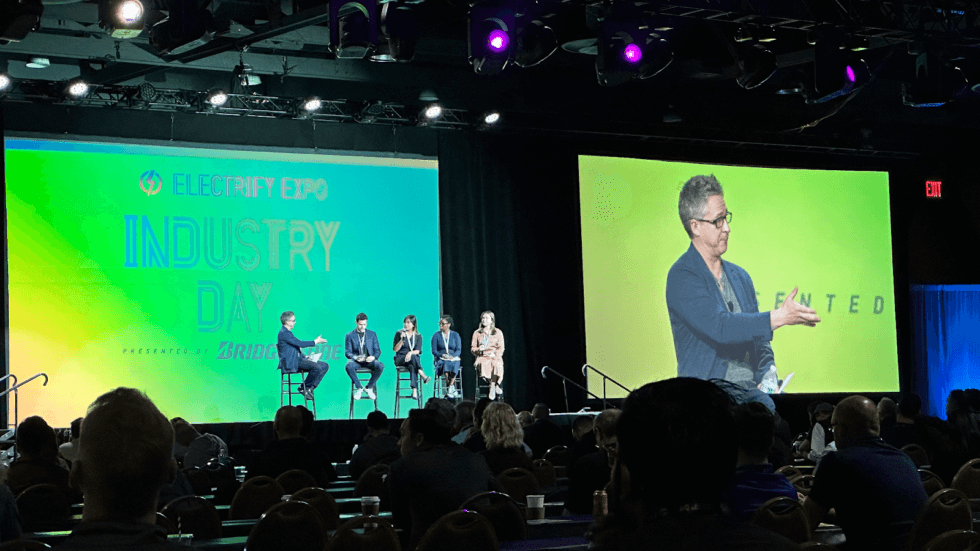View our Webinar on Demand: Apply Anycast Best Practices for Resilient & Performant Global Applications


View our Webinar on Demand: Apply Anycast Best Practices for Resilient & Performant Global Applications




This May, NetActuate CEO Mark Mahle attended the Electrify Expo Industry Day in Long Beach, CA. The Electrify Expo is North America’s largest electric vehicle festival. The event was jam-packed with keynotes, technical discussions, and vendors all sharing and demonstrating how our electric future is taking shape.
There’s a real sense of the electric vehicle industry being the new Wild West. EV technology is changing so rapidly. Tremendous innovation is taking place.
Mark Mahle - NetActuate CEO
The Electrify Expo and Industry Day see many leaders and experts coming together across the breadth and depth of this industry. Amidst new regulations, standards, government bodies, and companies, everyone is working towards innovative new goals.
NetActuate has been working with OE (Original Equipment) and other partners for several years to make their vision of connectivity possible. Handling and managing large amounts of data requires significant infrastructure, and we have both a global presence and expertise in engineering various aspects such as vehicle dynamics, software development kits (SDKs), and control systems. This allows us to not only support electric vehicles (EVs) but also connect different Internet of Things (IoT) devices on a large scale.
We collaborate closely with our customers at the engineering level, improving customers’ efficiency and enabling them to innovate quickly and adapt to changes. NetActuate is a rapid response team that can help even the most complex OE companies innovate rapidly. Considering the competition from both small startups and large OE companies worldwide, the next seven years will be crucial in determining the success of many businesses.

One panel discussion titled “Fixing The EV Charging Problem,” stood out in particular. It was moderated by Matt Teske from Chargeway, and featured panelists Emily Dreibelbis from PC Mag, Kameale Terry from Charger Help, Ailsa Yew from Southern California Edison, and Zander Isaacson from Xeal Energy. The discussion focused on the partnerships and challenges associated with EV charging infrastructure.
The EV charging landscape is filled with numerous complex challenges. Every component involved – from the vehicle to the charger to the entire charging infrastructure – must work seamlessly to provide a positive consumer experience. What’s the use of constructing EV chargers if the utility company can’t supply power to them? Or, what if a consumer arrives only to find they can’t charge their vehicle due to adapter requirements or incompatible software on their phone or vehicle?
EV drivers today often encounter various systems, rife with tedious, frustrating issues. For example, the headache of creating multiple accounts with different payment methods just to access a charger. There may also be situations where the charger itself is unavailable, if someone is using it or it is out of service. Purchasing gas is a far simpler process, and many businesses and experts want to make it just as convenient and straightforward to charge your car.

So, how does the network play a role in addressing these challenges? Zander Isaacson from Xeal discussed their NFC (Near Field Communication) and distributed ledger technology, which allows EV drivers to charge their cars without internet access. This design enhances both security and accessibility, leveraging a blockchain/ledger trust model to make the charging process seamless. With this approach, users can simply tap their phone to the charger, charge their vehicle, and when they regain internet signal or come near other distributed devices, their payment is automatically updated.
Anycast technology could also be used to make this model more widespread and performant. BGP anycast networking, which allows for multiple edge locations to be discoverable via a single IP address, would make it easier to deploy data processing gateways to the edge network closest to the consumer and the charging station.
Anycast also incorporates built-in network-level failover, which can improve various pain points not only for EV chargers but also for any network system today. This includes connected kiosks, point-of-sale (POS) systems, and more. Furthermore, anycast makes AI models more performant and reliable, allowing them to engage with consumers more authentically, without delays or downtime.
We left the conference optimistic about both our electric and connected future. The technology can help not only reduce carbon emissions and our planet, but enable us as humans to be more efficient, more effective and collaborative. It’s hard not to consider the implications of what this technology can do when combined with the power of the internet and the billions of people participating in our world each day.

Reach out to learn how our global platform can power your next deployment. Fast, secure, and built for scale.
.svg)